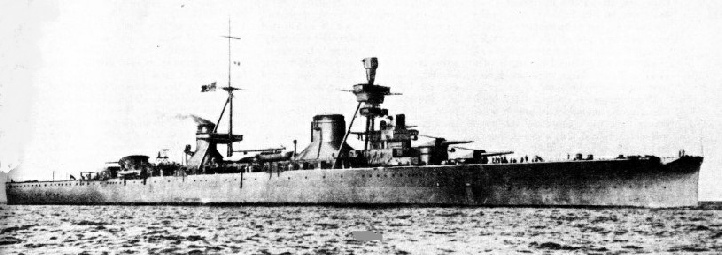

| Binding |
| Cookie Policy |
| Donate |
| FAQs |
| Illustrations |
| Links |
| More on Shipping Wonders |
| Other Series |
| Privacy Policy & Terms of Use |
| List of Illustrations |
| Ship Illustrations |
| Part 1 |
| Part 2 |
| Part 3 |
| Part 4 |
| Part 5 |
| Part 6 |
| Part 7 |
| Part 8 |
| Part 9 |
| Part 10 |
| Part 11 |
| Part 12 |
| Part 13 |
| Part 14 |
| Part 15 |
| Part 16 |
| Part 17 |
| Part 18 |
| Part 19 |
| Part 20 |
| Part 21 |
| Part 22 |
| Part 23 |
| Part 24 |
| Part 25 |
| Part 26 |
© Shipping Wonders of the World 2012-

The Italian Navy
During the war of 1914-
FLEETS OF THE FOREIGN POWERS -

SPEED WAS INCREASED FROM 22 TO 27 KNOTS and horse-
MARKED originality has always been shown by Italy in the design of her fighting ships. Nearly sixty years ago she startled the world by building two monster ships, the Italia and the Lepanto, which were undoubtedly the forerunners of the modern battle cruiser. They had the then unequalled displacement of nearly 14,000 tons, they were 400 feet in length, steamed at what was regarded as the extraordinary speed of 18 knots, and mounted the prodigious armament of four 100-
It is often claimed that the original dreadnought, or all-
The battleship Dreadnought was, however, an entirely British production, representing the perfection of an idea which had been discussed between Lord Fisher and Sir Phillip Watts as far back as 1882, when Fisher was Captain of the old Inflexible and Watts a young and progressive naval architect. Over twenty years later, when both men had reached the top of their respective professions, they collaborated in producing a modern version of their “ship of dreams”. By building the first all-
When Italy entered the war of 1914-
Previously the same officer had navigated another motor boat into the fortified harbour of Pola, and there had torpedoed and sunk an older Austrian battleship, the Wien. Few individuals in the war of 1914-
Mainly through enemy sabotage and submarine activities the Italian Navy lost many ships, and the end of the war found it sadly deficient in modern material. Under the Washington Treaty of 1922 Italy was accorded full naval equality with France, though at that time this parity existed only on paper. One of the first acts of Signor Mussolini on becoming Dictator was to draw up a comprehensive programme for the rejuvenation and expansion of the navy. From that time down to the present day the Italian fleet has developed unceasingly, and equality with France is well on the way to becoming an accomplished fact.
The Italian fleet is essentially a postwar creation, consisting as it does in the main of up-
Seven heavy and twelve light cruisers had been built, the majority of which were appreciably faster than any foreign vessel. The destroyer flotilla had been increased to well over 100 units, and the submarine armada brought to a total of nearly eighty boats, which made it numerically second only to that of France in vessels of modern construction.
The regeneration of Italian sea power, however, has not been confined to shipbuilding. The system of entering and training officers and seamen has been drastically revised and, although discipline has been tightened up, its severity is tempered by many amenities, such as improved living quarters, better food, and more facilities for recreation, which previously did not exist. Some years ago a large proportion of the lower-
The officers of the Italian Navy as a whole are studious, but in recent years increasing attention has been paid to the practical side of their profession by extending the period of exercises at sea and holding frequent manoeuvres. One example of the practical methods now in use may be cited. Every junior officer must undergo several months’ training in a destroyer flotilla. From time to time he is required to take full command of the flotilla, and put it through its paces at sea. This admirable system, which is believed to be peculiar to the Italian Navy, affords the best possible training for future command.
All the dockyards and bases used by the Italian fleet have been modernized and re-
The main State dockyard is at Spezia, on the Gulf of Genoa. Next in importance is the naval establishment at Venice, and there are subsidiary bases at Naples, Taranto, Gaeta (north of Naples), and also in Sardinia and Sicily. More recently a well-
The fleet is weak in capital ships but exceptionally strong in all other combatant types. Including two under construction, there are only six capital units. Those building, but not likely to be completed until 1938-

AN EARLY ARMOURED CRUISER of 6,299 tons displacement, the Francesco Ferruccio was completed in 1905. Reciprocating engines of 13,635 horse-
The machinery is designed for 125,000 horse-
There are four pre-
Fitted with an entirely new propelling plant, their horse-
Eventually, therefore, Italy will have four fast and powerful capital ships which will constitute the backbone of her fleet. Moreover, similar reconstruction of the Caio Duilio and the Andrea Doria is contemplated.
Italy has already completed seven heavy cruisers of the 10,000-
World’s Fastest Cruisers
Probably the most interesting ships in the Italian Navy are the light cruisers of the so-
The designed speed of 37 knots has been exceeded in every instance. One ship, the Alberico da Barbiano, attained a maximum of 42 knots on her trials and subsequently ran for eight hours at an average speed of 39¾ knots.
These small cruisers are therefore veritable “wonder ships”, and their tremendous speed has not been obtained at the cost of strength or seaworthiness. In the later ships of the same group the displacement has been increased to 5,857 and 6,791 tons and the armament is said to comprise ten 6-
The Italian destroyer force is largely of modern construction, nearly seventy units having been built since 1922. It is headed by a group of twelve flotilla leaders named after famous Italian navigators. These vessels have a displacement of 1,628 tons, a designed speed of 38 knots and an armament of six 4.7-
These fine vessels have proved exceedingly fast in service, one of them, the Alvise da Mosto, being credited with a speed of 45 knots. The average Italian destroyer of modern design is a one-

DESIGNED FOR DEEP DIVING the submarine Antonio Sciesa is of the same class as the Domenico Millefire, which, it is claimed, broke the world’s record for deep diving when she reached a depth of 66 fathoms (396 feet) in 1928. Of 1,363 tons surface displacement, the Antonio Sciesa was completed in 1929 and has a surface speed of more than 17 knots. Her submerged speed is 9J knots. She has an overall length of 282 feet, a beam of 24 ft. 6 in. and a mean draught of 14 feet
Probably because of the dramatic successes achieved by her small torpedo launches during the war of 1914-
No branch of the Italian Navy has undergone more rapid development than the submarine service. Between 1926 and 1936 nearly seventy new boats were built, ranging from ocean-
Italian submarines are well up to the international standard of efficiency and second to none in excellence of design and construction. It was unofficially reported in 1936 that the Italian Government aimed to raise the submarine establishment to a strength of 100 first-
Since the Italian Navy is intended primarily to operate in the Mediterranean, where distances are comparatively short, it does not feel the need for large aircraft carriers so acutely as do oceanic fleets such as the British and American. The only Italian carrier is the Miraglia, a converted merchantman of 4,960 tons, with a speed of 21½ knots, equipped with twenty planes and catapults fore and aft for launching purposes.
Aircraft Co-
On the other hand, Italy has developed to a high degree the tactical co-
In 1936 the personnel of the navy numbered about 3,000 officers and 50,000 men. The men included a fair proportion of long-
New recruits receive their preliminary training in shore establishments, of which the naval school at Trieste is a recent example. In this large and well-
The fact that Italy alone among the great Powers has no direct access to the ocean is constantly being stressed by her statesmen and publicists. To reach the Atlantic and the New World her ships must pass through the Straits of Gibraltar, and her only outlet to the Pacific and the Far East is through the Suez Canal. She cherishes the ambition, therefore, to become mistress of what she regards and calls her “own” sea, the Mediterranean. That she will attain complete supremacy over the entire Middle Sea is extremely doubtful, having regard to the fact that other Powers have vital interests there. Italy, however, holds a key position which a strong navy operating in
conjunction with a powerful air force would enable her to exploit to the utmost in certain eventualities.

ONE OF THE ITALIAN HIGH SEA TUGS (known officially as Rimorchiatori d'Alto Mare), the Ciclope is a twin-
Midway on the main traffic route through the Mediterranean, which must be traversed by all ships operating between Gibraltar and Suez, there is a comparatively narrow defile or bottleneck formed by Sicily on the north-
On paper it may seem that such command could be established without much difficulty, given the requisite degree of naval and air power. In practice, however, it might prove difficult to the point of impossibility, for British experience in 1914-
All these problems have doubtless been taken into consideration by those responsible for Italian naval policy. Moreover, Italy does not necessarily assume that in any future conflict she would be left to fight single-
The Italian Admiralty, housed in a new and stately building on the banks of the River Tiber, is organized on much the same plan as the British, with separate divisions for intelligence, planning, operations, naval construction, engineering and armament. The staff is comparatively large, and includes admirals on the active and on the retired list. High naval rank is occasionally bestowed on distinguished civilians as a special mark of favour, among such recipients being the celebrated radio expert, Signor Marconi, who was appointed a rear-
In contrast to certain other admiralties, whose attitude to all innovation is decidedly conservative, the Italian naval authorities eagerly take up and exploit every promising technical idea that is submitted to them. This probably accounts for certain novel items of equipment, the value of which is self-
Another instance of the progressive spirit animating the Italian service is provided by the experiments that are continually being conducted to improve the efficiency of existing weapons and to evolve new methods of using them.
Thus in the early months of 1936 it became known that the Italian Navy had tried out a system of dropping torpedoes from the air by parachutes.
In attempting to assess the combatant power of any armed force we are confronted with one imponderable and incalculable factor — the quality and spirit of the personnel. Only the test of combat itself can settle that particular point, but there is no reason to doubt that the sailors of modern Italy are worthy of the fine ships in which they serve.
In the material sense the present-

AN UNUSUALLY HIGH SPEED of 35 knots is attained by the Italian cruiser Trento. Completed in 1929, she has a displacement of 10,000 tons and is armed with eight 8-
You can read more on “Italian Shipping”, “The Rex and the Conte de Savoia” and “Undersea Weapons” on this website.